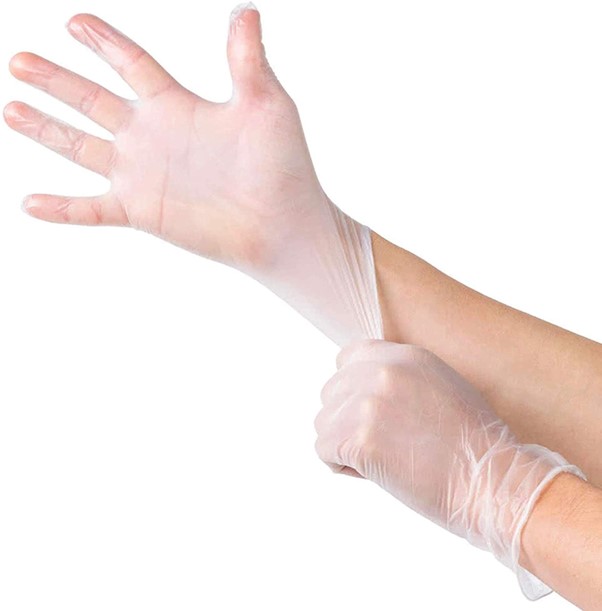Unnecessary usage of mass PVC gloves is causing considerable damage to the earth. PVC gloves do more harm than good to the environment and are ineffective in shielding wearers from contamination over time. So, to address the toxin hazards posed by PVC, governments and PVC gloves manufacturer businesses worldwide have implemented regulations to phase out PVC and convert to safer, healthier PVC-free products.
The potential consequences of PVC and its detrimental impact on human and environmental health are discussed below. Despite this overwhelming evidence to the contrary, vinyl (PVC) gloves continue to be the most often used disposable service glove in the healthcare, culinary, and printing industries.
Why Aren’t PVC Gloves Safe To Use?
Vinyl gloves have concerns about their microstructural arrangement, limiting their functionality and impact barrier protection. Studies show that the PVC polymer lacks cross-linking, and when combined with plasticizers, which damage the vinyl glove’s structure, micro-punctures will happen after just a few hand flexes. Additionally, the minute permeability of vinyl gloves to germs and viruses compromises food safety.
According to estimates, between 50-90% of punctures go unnoticed by the workers, contaminating surfaces that the gloves touch with. Vinyl gloves also have poor stretch and elongation resistance.
A thorough analysis of PVC’s effects on human health across its entire lifecycle, including production, disposal, and occupational exposure issues, showed that PVC causes the emission of hazardous amounts of dioxin and other carcinogens to the environment. The report determined that the phthalates DiNP and DEHP from PVC gloves are harmful to human health. That’s why they are not safe for human health and the environment.
Why Go For PVC-Free?
The following are some of the changes implemented around the world to move to safer, healthier PVC-free products as a result of the health and environmental risks posed by PVC:
- In 1995, Sweden first suggested limiting the use of PVC, and the country is currently attempting to eliminate PVC use.
- Healthcare facilities worldwide are reducing or have already eliminated PVC and phthalates from products, including vinyl gloves, due to concerns about harmful substances in products.
- PVC gloves for handling food were outlawed in Japan in 2001 due to adverse health impacts.
Despite all of the evidence against disposable vinyl gloves, why do they continue to be the most commonly used food handling glove, increasing food safety risks?
Cost is one consideration, and previous purchasing trends are another. Additionally, there is a lack of information from glove manufacturers about the risks that disposable vinyl gloves pose to PTFE products manufacturer, customers, and ultimately food handling businesses in terms of food safety. Food safety considerations are frequently overlooked when choosing gloves, creating a false sense of security and saving money.
Using PVC Gloves Is That Harmful And Shouldn’t Be Used?
There are benefits and drawbacks to everything. Vinyl gloves are not appropriate for handling water-based solutions and organic solvents. Knowing where PVC or vinyl gloves can be used securely and how to get rid of them is essential. There are vinyl variants with negligible levels of phthalates and chlorine.
Here are some tips for using PVC gloves safely:
- PVC gloves are a good choice for handling various non-hazardous materials.
- Do not use them if you are a surgeon or a chef.
- If you’re working in clean room injection molding, then use a fold disc when putting on PVC gloves to ensure they fit correctly.
Safe Alternatives To PVC Gloves
Nitrile and vinyl gloves are the two main synthetic substitutes that usually rule the market, and each has advantages and disadvantages for reducing the danger of cross-contamination. Nitrile gloves are vastly superior in comparison to vinyl gloves in barrier protection and chemical resistance. They are a secure and affordable alternative.
Nitrile gloves are now more robust, flexible, and fit, thanks to recent improvements in raw material compositions and glove manufacture. The risk of contamination from a disposable glove is reduced by the lower failure rates (holes and rips) associated with higher-quality nitrile gloves.
Better quality nitrile gloves feature unique surface properties with total surface energy and transfer qualities similar to Teflon, lowering the danger of potential cross-contamination. This is because of the raw material composition and techniques used during manufacture.
Concluding Thoughts
PVC gloves are the least expensive disposal gloves. Despite the drawbacks, these gloves are still a good option when worn correctly. Due to the presence of phthalates and chlorine, many countries have banned using PVC gloves in the food handling and medical fields.
There is a lot of responsibility involved with using PVC/vinyl gloves. So maybe it’s time to conduct some research to ensure the gloves in your facility aren’t endangering the safety of your food, environment, or health. They are helpful if you don’t wear PVC gloves in the industries above and just use them to handle non-hazardous materials.











